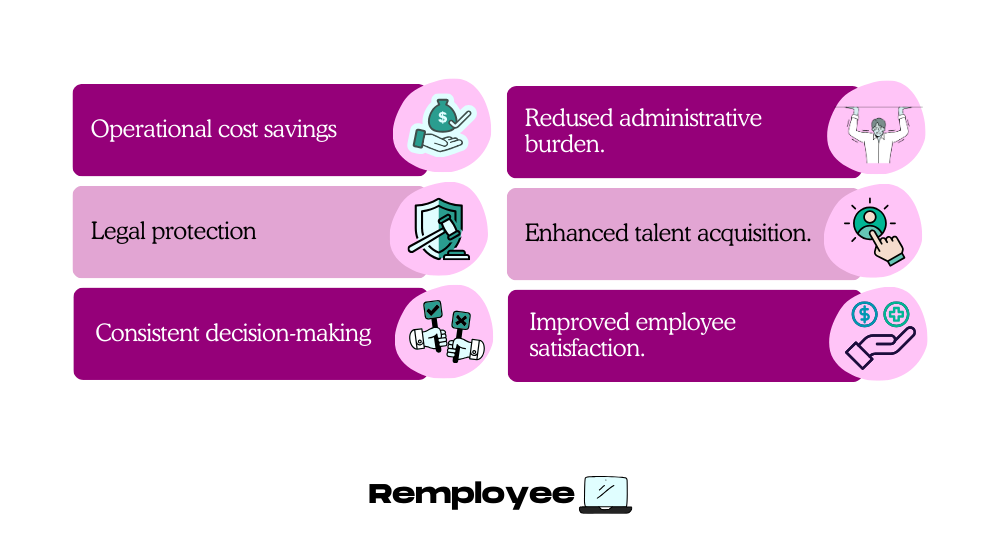What You’ll Learn from This Guide
👉 Why remote work policy MATTERS for your business.
👉 What you should INCLUDE in your remote work policy.
👉 How to CREATE a remote work policy in under 1 minute.
If it makes sense, keep reading.
Building a remote work policy feels overwhelming when you’re staring at a blank page, wondering if you’ve covered every possible scenario.
You know you need one.
Your team’s asking questions about equipment stipends, time zones, and security protocols.
Leadership wants clarity on performance metrics and accountability.
But where do you even start?
Most companies either overthink it (creating 50-page documents nobody reads) or underthink it (leaving massive gaps that create confusion later).
After helping dozens of organizations navigate remote work transitions, I’ve distilled the process into seven straightforward steps that cover everything you actually need.
Let’s get to it.
Why a Remote Work Policy Matters for Your Company?

A comprehensive remote work policy transforms chaos into clarity for your entire organization. Without documented guidelines, you’re fielding the same questions repeatedly, making inconsistent decisions, and creating frustrated employees who don’t know the rules.
A formal policy eliminates ambiguity and protects both your company and your workforce from misunderstandings that lead to legal issues or damaged relationships.
Your policy becomes the foundation for attracting this talent while maintaining operational excellence. Key benefits include:
- Operational cost savings from optimized resource allocation
- Legal protection from employment disputes and compliance violations
- Consistent decision-making across departments and managers
- Reduced administrative burden through predetermined guidelines
- Enhanced talent acquisition by offering structured flexibility
- Improved employee satisfaction through clear expectations
Skip to the Remote Work Policy Generator 👈🏽
Goals, Scope, and Legal Requirements
Your remote work policy needs a foundation before you dive into specifics. Start by defining what you want this policy to achieve—cost savings, talent retention, or geographic expansion all require different approaches.
Next, determine scope: which roles qualify, which departments are excluded, and whether this applies to contractors. Legal requirements vary dramatically by location, so consult your legal team about:
- State tax implications for remote employees
- Workers’ compensation coverage across state lines
- Labor law compliance in each employee’s location
- Data privacy regulations (especially for international workers)
- Equipment liability and insurance requirements
Skip this groundwork and you’ll find yourself rewriting everything when legal catches wind of your policy three months later.
Step 1: Define Eligibility, Employment Status, and Locations
Eligibility criteria form the backbone of your remote work policy. Specify which positions qualify for remote work based on job requirements, not personal preferences. Customer-facing roles might need hybrid arrangements while developers work fully remote.
Address employment classifications clearly—full-time remote differs from occasional work-from-home privileges. Geographic boundaries matter more than most companies realize. Some organizations limit remote work to specific time zones for meeting coordination. Others restrict certain states due to remote work tax complexity.
Be explicit about temporary relocations versus permanent moves—they have different implications.
Step 2: Set Work Hours, Availability, and Time Zones
Work hours in remote settings require crystal-clear boundaries to prevent burnout and ensure collaboration. Specify core hours when everyone must be available—typically a 4-hour window that overlaps across time zones.
Outside core hours, give employees flexibility to structure their day around personal productivity peaks. This helps reduce remote work fatigue and and enables employees to handle personal responsibilities without guilt or schedule conflicts.
Document response time expectations for different communication channels: immediate for Slack during core hours, 24 hours for email, scheduled for deep work blocks.
Tools like Clockify or Toggl simplify time tracking without micromanaging, automatically generating reports that show when people are working without invasive screenshot monitoring. These platforms integrate with project management systems to connect hours worked with actual output, shifting focus from time-in-seat to results delivered.
Step 3: Specify Equipment, Stipends, and IT Support
Equipment policies are part of your employer obligations, and they prevent the nightmare of inconsistent setups and security vulnerabilities across your remote workforce. Define what the company provides versus employee responsibilities—laptop and core software from you, desk and chair preferences on them.
Set clear stipend amounts for home office setup ($1,000-$1,500 is standard) and monthly internet/phone reimbursement ($50-$100 typically).
Equipment Comparison:
Include IT support parameters: response times, remote access permissions, and troubleshooting protocols for home networks.
Step 4: Establish Security, Privacy, and Data Handling
Security protocols become exponentially more complex when your workforce operates from kitchen tables and coffee shops. Define minimum requirements for home networks—password-protected WiFi, VPN usage for sensitive data, and restrictions on public network access.
Specify which data can live on local machines versus cloud-only storage. Include guidelines for physical security: locked screens when stepping away, secure document disposal, and restrictions on who can view work materials.
Address video call backgrounds and what’s visible during meetings—client information on whiteboards or sensitive documents in view create unnecessary risks. Clarify consequences for security violations, from additional training requirements to termination for severe breaches.
Step 5: Clarify Communication Channels, Meetings, and Expectations
Communication chaos kills remote productivity faster than any technical glitch. Map each channel to its purpose: Slack for quick questions, email for formal decisions, video calls for brainstorming sessions.
Set meeting hygiene standards that respect everyone’s time and energy. Cameras on or off? Record meetings or keep them live-only? How much notice for scheduling? Create guidelines for asynchronous communication:
- Thread responses to maintain context
- Use status indicators accurately
- Document decisions in shared spaces
- Tag relevant people without over-notifying
- Respect focus time and time zones
Establish escalation paths for urgent issues versus standard requests. Nothing frustrates remote workers more than unclear expectations about response times and availability.
Step 6: Define Performance Metrics, Feedback, and Accountability
Performance management shifts dramatically when you can’t see people working. Focus on outcomes and deliverables rather than activity metrics.
Define specific, measurable goals for each role—project completion rates, customer satisfaction scores, or revenue targets work better than hours logged. Schedule regular one-on-ones weekly or biweekly to maintain connection and catch issues early.
Document performance conversations more thoroughly than you would in-office, since casual hallway feedback doesn’t exist remotely.
Platforms like 15Five or Culture Amp facilitate continuous feedback loops, replacing annual reviews with ongoing performance dialogues that track goal progress, gather peer input, and flag concerns before they become termination conversations.
These tools create transparency around expectations while building a performance record that protects both parties.
Step 7: Outline Training, Change Management, and Rollout Plan
Rolling out your remote policy without proper change management guarantees confusion and resistance. Start with manager training—they’re your front line for questions and enforcement. Cover policy interpretation, remote management skills, and available resources.
Create different training tracks for newly remote employees versus experienced remote workers joining your company.
Build feedback mechanisms from day one—surveys, focus groups, or dedicated Slack channels where people can raise concerns without fear.
Use a Remote Work Policy Generator
Your remote work policy shouldn’t require starting from scratch or hiring expensive consultants. Our policy generator tool walks you through each section with prompts and examples, automatically adjusting language based on your industry and company size.
Simply answer questions about your work arrangements, and the generator creates a customized first draft in under one minute. Export directly to Word or Google Docs for final edits and legal review.
The generator includes built-in compliance checks for common state requirements and flags sections that might need legal consultation based on your employee locations.
Use a Remote Work Policy Generator now!👈🏽
After years of freelancing through broken systems and vague job boards, Josie built Remployee to help others find what she couldn’t at first: flexible work that feels like freedom, not chaos. She believes real jobs should fit real lives—and that thoughtful writing can be a bridge to better work. If you’re looking for permission to choose differently, Josie’s already given it.



